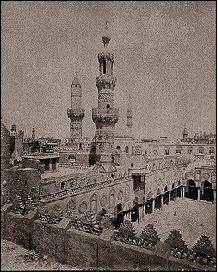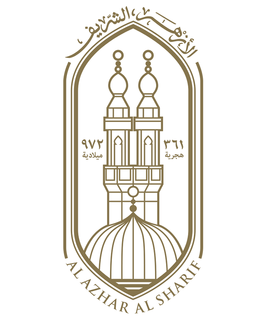Al-Azhar (Arabic : الأزهرal-azhar) may refer to:

The Mosque of al-Hakim, nicknamed al-Anwar, is a historic mosque in Cairo, Egypt. It is named after Al-Hakim bi-Amr Allah (985–1021), the sixth Fatimid caliph and 16th Ismaili Imam. Construction of the mosque was originally started by Caliph al-'Aziz, the son of al-Mu'izz and the father of al Hakim, in 990 AD. It was completed in 1013 by al-Hakim, which is why it is named after him.

The Al-Azhar University is a public university in Cairo, Egypt. Associated with Al-Azhar Al Sharif in Islamic Cairo, it is Egypt's oldest degree-granting university and is renowned as the most prestigious university for Islamic learning. In addition to higher education, Al-Azhar oversees a national network of schools with approximately two million students. As of 1996, over 4,000 teaching institutes in Egypt were affiliated with the university.

Islam is the dominant religion in Egypt with around an estimated 90.3% of the population. Almost the entirety of Egypt's Muslims are Sunnis, with a very small minority of Shia.Islam has been recognized as the state religion since 1980. Since there has been no religious census, the actual percentage of Muslims is not known: the percentage of Christians are estimated to be between 5 and 15%.

Islamic Cairo, also called Historic Cairo or Medieval Cairo, refers generically to the historic areas of Cairo, Egypt, that existed before the city's modern expansion during the 19th and 20th centuries; particularly the central parts around the old walled city and around the Citadel of Cairo. The name "Islamic" Cairo refers not to a greater prominence of Muslims in the area but rather to the city's rich history and heritage since its foundation in the early period of Islam, while distinguishing it from with the nearby Ancient Egyptian sites of Giza and Memphis. This area holds one of the largest and densest concentrations of historic architecture in the Islamic world. It is characterized by hundreds of mosques, tombs, madrasas, mansions, caravanserais, and fortifications dating from throughout the Islamic era of Egypt. In 1979, the United Nations Educational, Scientific and Cultural Organization (UNESCO) proclaimed Historic Cairo a World Cultural Heritage site, as "one of the world's oldest Islamic cities, with its famous mosques, madrasas, hammams and fountains" and "the new centre of the Islamic world, reaching its golden age in the 14th century."

Muhammad Sayyid Tantawy, also referred to as Tantawi, was an influential Islamic scholar in Egypt. From 1986 to 1996, he was the Grand Mufti of Egypt. In 1996, president Hosni Mubarak appointed him as the Grand Imam of Al-Azhar, a position he retained until his death in 2010.

Abdal-Hamid Kishk was an Egyptian preacher, scholar of Islam, activist, and author. He was a graduate of Al-Azhar University in Cairo and was known for his humour, popular sermons, and for his outspoken stance against music, restrictions on polygamy, and injustice and oppression in the Muslim world.

Ahmed Subhy Mansour is an Egyptian American activist, Islamic Quranist scholar dealing with Islamic history, culture, theology, and politics. He founded a small Egyptian Quranist group that is neither Sunni nor Shia, was exiled from Egypt, and lives in the United States as a political refugee.

Al-Muizz li-Din Allah al-Fatimi Street, or al-Muizz street for short, is a major north-to-south street in the walled city of historic Cairo, Egypt. It is one of Cairo's oldest streets as it dates back to the foundation of the city by the Fatimid dynasty in the 10th century, under their fourth caliph, Al-Mu'izz li-Din Allah . Historically, it was the most important artery of the city and was often referred to as the Qasaba. It constituted the main axis of the city's economic zones where its souqs (markets) were concentrated. The street's prestige also attracted the construction of many monumental religious and charitable buildings commissioned by Egypt's rulers and elites, making it a dense repository of historic Islamic architecture in Cairo. This is especially evident in the Bayn al-Qasrayn area, which is lined with some of the most important monuments of Islamic Cairo.

Mahmoud Khalil al-Hussary, also known as Al-Hussary, was an Egyptian Qari widely acclaimed for his accurate recitation of the Qur'an. Al-Hussary committed the entire Qur'an to memory by age 8 and started reciting at public gatherings by age 12. In 1944, Al-Hussary won Egypt Radio's Qu'ran Recitation competition which had around 200 participants, including veterans like Muhammad Rifat. The quadrumvirate of El Minshawy, Abdul Basit, Mustafa Ismail, and Al-Hussary, who belong to the famous and well-respected "Egyptian Reciting School", are generally considered the most important and famous Qurra' of modern times to have had an outsized impact on the Islamic world.

The Aqmar Mosque, was built in Cairo, Egypt, as a neighborhood mosque by the Fatimid vizier al-Ma'mun al-Bata'ihi in 1125-6 CE. The mosque is situated on what was once the main avenue and ceremonial heart of Cairo, known today as al-Mu'izz Street, in the immediate neighborhood of the former Fatimid caliphal palaces. The mosque is an important monument of Fatimid architecture and of historic Cairo due to the exceptional decoration of its exterior façade and the innovative design of its floor plan.

Al-Azhar Mosque, known in Egypt simply as al-Azhar, is a mosque in Cairo, Egypt in the historic Islamic core of the city. Commissioned by Jawhar al-Siqilli shortly after Cairo was established as the new capital of the Fatimid Caliphate in 970, it was the first mosque established in a city that eventually earned the nickname "the City of a Thousand Minarets". Its name is usually thought to derive from az-Zahrāʾ, a title given to Fatimah, the daughter of Muhammad.

Ahmed Mohamed Ahmed El-Tayeb is an Egyptian Islamic scholar and the current Grand Imam of al-Azhar, Al-Azhar Al Sharif and former president of al-Azhar University. He was appointed by the Egyptian President, Hosni Mubarak, following the death of Mohamed Sayed Tantawy in 2010. He is from Kurna, Luxor Governorate in Upper Egypt, and he belongs to a Sunni Muslim family.

The Fatimid architecture that developed in the Fatimid Caliphate (909–1167 CE) of North Africa combined elements of eastern and western architecture, drawing on Abbasid architecture, Byzantine, Ancient Egyptian, Coptic architecture and North African traditions; it bridged early Islamic styles and the medieval architecture of the Mamluks of Egypt, introducing many innovations.
Shia Islam in Egypt is composed of the highly persecuted low profile Shia Muslim community of Egypt.
Gamal Abdel Nasser (1918–1970) was the second President of Egypt 1954–1970.

The Ahmadiyya is an Islamic movement in Egypt with origins in the Indian subcontinent. Although the earliest contact between Egyptians and the Ahmadiyya movement was during the lifetime of Mirza Ghulam Ahmad, its founder, the movement in Egypt was formally established in 1922 under the leadership of its second Caliph Opposition to the Ahmadiyya grew particularly in the latter part the 20th century and Ahmadis have seen increased hostility in Egypt more recently. There are up to 50,000 Ahmadi Muslims in Egypt. Although the group is not officially recognised by the state.
At 1:50 PM EET on 24 November 2017, the al-Rawda mosque was attacked by roughly 40 gunmen during Friday prayers. The mosque is located in the village of Al-Rawda east of the town of Bir al-Abed in Egypt's North Sinai Governorate. It is one of the main mosques associated with the Jaririya Sufi order, one of the largest Sufi orders in North Sinai. The Jaririya order is named for its founder, Sheikh Eid Abu Jarir, who was a member of the Sawarka tribe and the Jarira clan. The Jarira clan resides in the vicinity of Bir al-Abed. The attack killed 311 people and injured at least 128, making it the deadliest attack in Egyptian history. It was the second-deadliest terrorist attack of 2017, after the Mogadishu bombings on 14 October. The attack was universally condemned by many world leaders and organizations.
Abla al-Kahlawi was an Egyptian scholar and teacher of Islamic jurisprudence, as well as a religious leader, preacher, and television presenter. She taught at Al Azhar University in Cairo, Egypt, where she was the Dean of the Faculty of Islamic and Arabic Studies at the Women's College. She was listed on the inaugural edition of The 500 Most Influential Muslims for her work on religion and women, in 2009, and has published widely on women and Islamic jurisprudence. She preached in Egypt, in person and on television, as well as in Saudi Arabia, and notably preached every day for two years at the Masjid al-Ḥaram, Islam's most important mosque in Saudi Arabia, between 1987 and 1989.

Al-Azhar Al-Sharif is an Islamic scientific body and the largest religious institution in Egypt. Its headquarters is located in the building of the Sheikhdom of Al-Azhar in the center of the Egyptian capital, Cairo. The history of the establishment of the Al-Azhar Mosque dates back to the year 972 by the Fatimid Caliph Al-Muizz Li-Din Allah. It is considered the third oldest university in the world after Al-Zaytoonah and Al-Qarawiyyin universities.